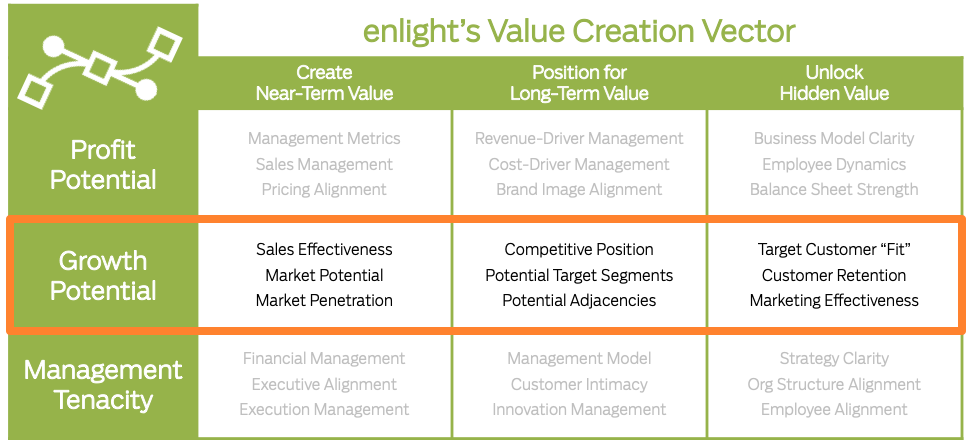
In our last post about the Value Creation Vector, we dug into the first lever, Profit Potential. Today we’re going to look at the second lever: Growth Potential. Once we have assurance that you’re maxing out the profit potential of your business, we want to help you grow the sh*t out of it.
As a refresher, here’s what I wrote about Growth Potential in the original Value Creation Vector post:
Once you’re comfortable that your company is performing at its peak, attention can turn to growing the “machine.” Assessing growth potential in a structured way helps focus energy first on why to grow – then where and how to grow.
So, what do we consider when we assess a company’s growth potential? We evaluate several growth factors that Create Near-Term Value, position the company for Long-Term Value and Unlock Hidden Value.

Create Near-Term Value
Just like with profit potential, we start the growth potential assessment with the near-term factors because small changes in these factors can have significant and immediate impacts on growth.
The factors we consider are:
1. Sales Effectiveness – Is your sales team operating effectively and using the most effective best practices?
We want to understand if the sales team:
- Identifies Potential Customers
- Converts Customers
- Utilizes Sales Tools
- Monitors Individual Performance
2. Market Penetration – How big is the market opportunity with target customers and has the company sufficiently penetrated that segment?
We want to understand the basics of the current target customer segment:
- Target Segment Size
- Target Segment Growth
- Target Segment Penetration
- Market Share & Potential
3. Market Potential – How big is the opportunity? How broad is your reach? What are the basic dynamics of the market?
We want to understand the basics of current geographic coverage:
- Geographic Reach & Potential
- Online Reach & Potential
- Synergy
- Seasonality
Position for Long-Term Value
The factors that help a company capture long-term value require more time to plan and operationalize. Just like with profit potential, these factors improve the company’s proactivity, productivity and resilience over the long-term.
The factors we consider are:
1. Competitive Position – What is your competitive situation, and do you have a realistic understanding of it?
We want to understand whether the management team has an objective understanding of:
- Relevant Competitors
- Competitor Strengths
- Competitor Strategies
- Competitive Market Share
2. Potential Target Segments – What new customer segments are likely sources of growth?
We want to understand the extent to which your management team has identified:
- Target Customer Benefits
- Adjacent Segments
- Value Chains
- Target Segment Margin Potential
3. Potential Adjacencies – What new products or services are likely sources of growth.
We want to understand if leadership has identified:
- Potential Customer Needs
- Product/Service Opportunities
- Customer Inspiration & Input
- New Products and Services Margin Potential
Unlock Hidden Value
The factors that unlock hidden value are often overlooked and not necessarily intuitive. However, they are often the most important, making the company stronger and improving growth potential.
The factors we consider are:
1. Target Customer ‘Fit’ – Are current target customers really a good fit with your company’s strategy, goals and capabilities?
We want to understand if there are hidden limitations in the current target market because of:
- Customer Benefit ‘Fit’
- Willingness to Pay
- Segment Size
- Option Value
2. Customer Retention – Is your company running in place because all the growth is negated by lost customers?
We want to size up hidden growth limitations from customer attrition:
- Retention Metrics
- Retention Accountability
- Culture of Service
- Retention Plans
3. Marketing Effectiveness – Is your company sending mixed signals through its marketing and ‘self-sabotaging’ the growth potential?
We want to identify any hidden marketing factors that limit growth:
- Marketing Reach
- Marketing Relevance
- Brand Alignment
- Customer Attraction
You have your profit potential in order and your company is well-poised to grow that profit over the near and long-term. How do you make sure all that potential value is realized? That’s where Management Tenacity comes in. We’ll discuss the critical but sometimes forgotten importance of Management Tenacity in an upcoming post.

